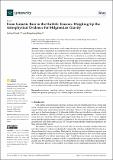Files in this item
From galactic bars to the Hubble tension : weighing up the astrophysical evidence for Milgromian gravity
Item metadata
| dc.contributor.author | Banik, Indranil | |
| dc.contributor.author | Zhao, Hongsheng | |
| dc.date.accessioned | 2022-06-28T09:30:14Z | |
| dc.date.available | 2022-06-28T09:30:14Z | |
| dc.date.issued | 2022-06-27 | |
| dc.identifier | 279724688 | |
| dc.identifier | dc385cfc-128f-45aa-ac3d-bc8bd8aea01f | |
| dc.identifier | 000832101600001 | |
| dc.identifier | 85194106716 | |
| dc.identifier.citation | Banik , I & Zhao , H 2022 , ' From galactic bars to the Hubble tension : weighing up the astrophysical evidence for Milgromian gravity ' , Symmetry , vol. 14 , no. 7 , 1331 . https://doi.org/10.3390/sym14071331 | en |
| dc.identifier.issn | 2073-8994 | |
| dc.identifier.other | ArXiv: http://arxiv.org/abs/2110.06936v9 | |
| dc.identifier.uri | https://hdl.handle.net/10023/25571 | |
| dc.description | Funding: IB is supported by Science and Technology Facilities Council grant ST/V000861/1, which also partially supports HZ. IB acknowledges support from a "Pathways to Research" fellowship from the University of Bonn. | en |
| dc.description.abstract | Astronomical observations reveal a major deficiency in our understanding of physics—the detectable mass is insufficient to explain the observed motions in a huge variety of systems given our current understanding of gravity, Einstein’s General theory of Relativity (GR). This missing gravity problem may indicate a breakdown of GR at low accelerations, as postulated by Milgromian dynamics (MOND). We review the MOND theory and its consequences, including in a cosmological context where we advocate a hybrid approach involving light sterile neutrinos to address MOND’s cluster-scale issues. We then test the novel predictions of MOND using evidence from galaxies, galaxy groups, galaxy clusters, and the large-scale structure of the universe. We also consider whether the standard cosmological paradigm (LCDM) can explain the observations and review several previously published highly significant falsifications of it. Our overall assessment considers both the extent to which the data agree with each theory and how much flexibility each has when accommodating the data, with the gold standard being a clear a priori prediction not informed by the data in question. Our conclusion is that MOND is favoured by a wealth of data across a huge range of astrophysical scales, ranging from the kpc scales of galactic bars to the Gpc scale of the local supervoid and the Hubble tension, which is alleviated in MOND through enhanced cosmic variance. We also consider several future tests, mostly at scales much smaller than galaxies. | |
| dc.format.extent | 147 | |
| dc.format.extent | 8378493 | |
| dc.format.extent | 9493293 | |
| dc.language.iso | eng | |
| dc.relation.ispartof | Symmetry | en |
| dc.subject | Gravitation | en |
| dc.subject | Cosmology | en |
| dc.subject | Galaxies: kinematics and dynamics | en |
| dc.subject | Galaxies: evolution | en |
| dc.subject | Galaxies: interactions | en |
| dc.subject | Galaxies: groups | en |
| dc.subject | Galaxies: clusters | en |
| dc.subject | Large-scale structure of Universe | en |
| dc.subject | QB Astronomy | en |
| dc.subject | QC Physics | en |
| dc.subject | MCC | en |
| dc.subject.lcc | QB | en |
| dc.subject.lcc | QC | en |
| dc.title | From galactic bars to the Hubble tension : weighing up the astrophysical evidence for Milgromian gravity | en |
| dc.type | Journal item | en |
| dc.contributor.institution | University of St Andrews. School of Physics and Astronomy | en |
| dc.identifier.doi | https://doi.org/10.3390/sym14071331 | |
| dc.description.status | Peer reviewed | en |
| dc.identifier.url | https://arxiv.org/abs/2110.06936 | en |
This item appears in the following Collection(s)
Items in the St Andrews Research Repository are protected by copyright, with all rights reserved, unless otherwise indicated.


